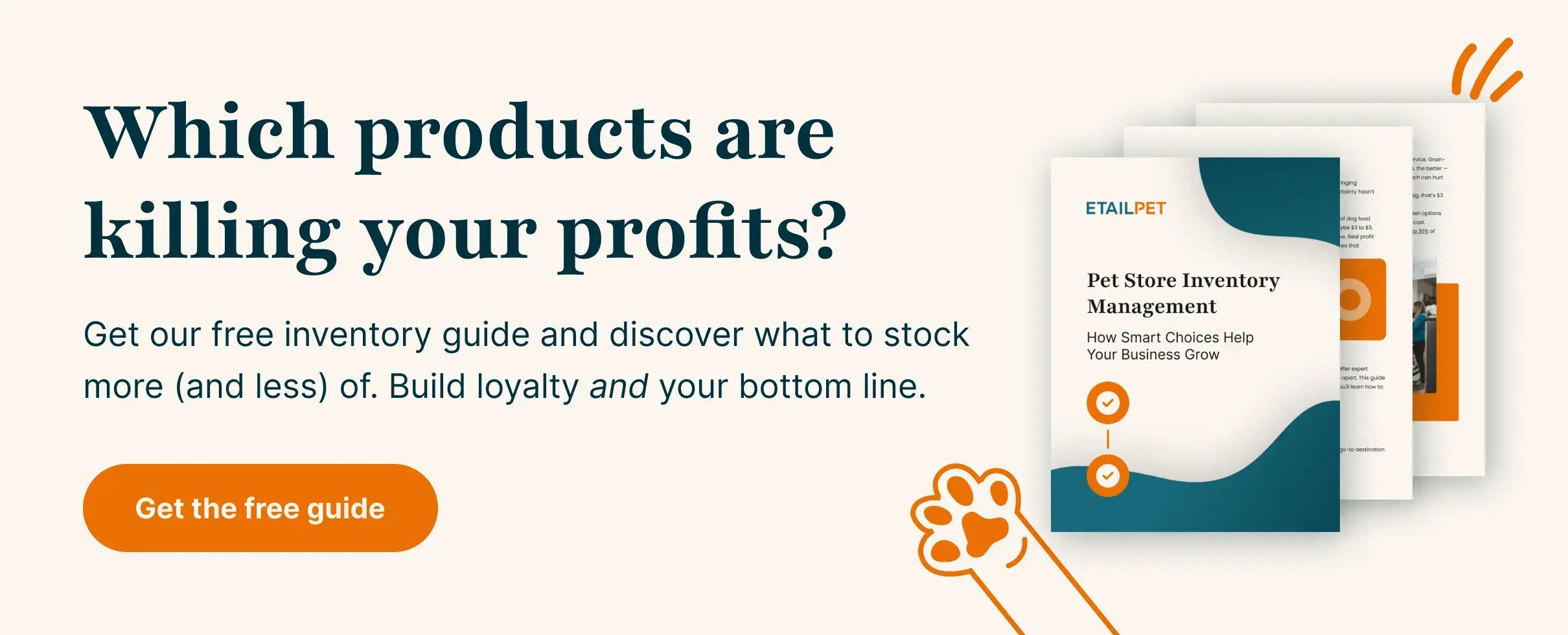
Pet parenting is officially in. Sorry, kids — Millennials and Gen Z are choosing to raise pets over having children. In fact, 43% of survey respondents say they’d rather have pets than kids. Why? Pets cost less, fit better into flexible lifestyles, and for many, feel just as rewarding.
Pets are cheaper to care for than children, but don’t confuse “cheaper” with “cheap.” Today’s pet parents are anything but stingy. Younger generations are actually spending more than twice as much on their pets compared to older generations. From premium food to pet tech, pet spending trends show that people are going all in for their furry companions.
For pet store owners, this is good news. In this blog, we’re diving into the latest pet spending trends — where pet owners are spending the most and what that means for your business.
Let’s get started.
The Numbers Behind Pet Spending
In 2024, the U.S. pet industry topped $150 billion — and it’s not slowing down anytime soon. By 2030, it’s projected to hit nearly $200 billion. No shocker here: dogs still hold the crown, with 44% of pet-owning households claiming at least one. Cats follow close behind, keeping the rankings competitive.
As pets continue to be treated like family, owners are shelling out more than ever — especially on nonessentials like gourmet treats, stylish accessories, and pet insurance. By the end of 2024, there were 6.25 million pets insured across North America, a 16% increase from just two years prior.
Here’s how today’s pet spending trends are divided by category, according to the American Pet Products Association (APPA):
- Pet food & treats: $66.9 billion (44.42%)
- Veterinary care & product sales: $39.1 billion (25.96%)
- Supplies, live animals, & OTC medicine: $32.0 billion (21.25%)
- Other services: $12.6 billion (8.37%)*
*Other services include offerings like grooming, boarding, training, pet sitting, and insurance.
Huge numbers, right? But what do they really mean for your pet store? Let’s zoom in: who’s doing the most spending, what exactly they’re buying, and whether this surge is just a trend or a long-term shift in how we care for our pets.
Related Read: What Are the Top Pet Products To Sell in 2025? [& How To Manage Them]
Who Owns What Pets — and Where
If you want to stock your pet store smarter, it’s worth knowing who’s doing the most pet parenting — and where they live. Pet spending trends aren’t random. They’re shaped by age, income, lifestyle, and location. The more you understand this, the better you can meet your customers where they are.
Millennials now make up the largest share of pet owners at 33%, followed by Gen Z at 25%, and Baby Boomers at 24%. But ownership is just part of the story — spending tells you even more. Millennials spend an average of $5,150 a year on their pets, while Gen Z is already outspending them at around $6,100 annually. Boomers still love their pets, but their yearly spending is lower, averaging about $2,450.
This generational breakdown matters:
- Millennials and Gen Z lean into premium food, pet wellness, sustainable products, and tech like GPS collars and pet cams.
- Boomers tend to focus more on health essentials — like supplements or vet-recommended diets.
Income plays a role in what — and how much — pet owners spend, too. Households making over $100,000 a year are more likely to own multiple pets, and those pets are usually dogs. These owners are also more inclined to spend on high-end products, luxury services, and subscription boxes. Lower-income households (under $20,000) are less likely to own pets, and when they do, they tend to stick to the essentials and keep it budget-friendly.
And then there’s geography. Where people live has a huge impact on how they care for their pets — and how much they spend:
- Homeowners are more inclined to own dogs, have the space for larger animals, and spend more on long-term pet needs.
- Apartment dwellers often go for smaller breeds or cats and are bigger spenders on services like pet sitting, grooming, and daycare.
- Rural pet owners are more likely to have multiple animals and are less likely to pay urban prices for services. A vet visit in rural Mississippi costs a lot less than one in downtown Chicago.
This isn’t a coincidence. The cost of pet care usually matches the cost of living. Pet parents in big cities may drop serious cash on boutique grooming or possibly acupuncture for their pets. In smaller towns, those services might not even be available — or necessary.
Related Read: Pet Store Customer Loyalty 101: The What, Why, and How
What This Means for Your Pet Store
What can you do with all this info on who’s spending what, where they live, and how they treat their pets? Use it. It gives you insight — and the freedom — to get creative with what you offer.
You’re not taking advantage of pet owners. You’re helping them show up for the animals they love. These pet spending trends are your opportunity to meet demand in a way that feels personal and local.
Let’s break it down:
- Live in a small town with an older crowd? Consider offering mobile grooming. Not everyone drives, and if your customer has mobility issues, they’re not hauling their golden retriever across town for a shampoo. Products like joint chews, pill pockets, or easy-lift harnesses might fly off the shelves faster than luxury collars or dog strollers.
- In a big city? Space is tight, and people are busy. If you’re not offering dog walking or delivery yet, you’re missing out. Rent too high for a brick-and-mortar store? Focus on online sales. You can still build a loyal following with fast shipping, smart bundles, or even a local pickup option. Think convenience, not square footage.
- Got a lot of high-income families in your area? They’re probably the ones with multiple pets — and they’re ready to spend. Stock up on premium food, specialty supplements, birthday treats, or gear for pets who travel or hike with their humans.
- Leaning more budget-conscious? Your customers still care deeply about their pets — they just need options that make sense for their wallets. That can mean carrying a solid range of affordable food, running loyalty programs, or offering buy-in-bulk discounts.
- Seeing lots of young pet parents? Millennials and Gen Z aren’t just buying toys — they’re buying values. That means products with a sustainability angle, natural ingredients, or brands with a good story. If it’s ethically made, eco-friendly, or somehow makes their pet’s life (and theirs) better, you’re on the right track.
You don’t need to guess what your customers want. You already know them. You live where they live. You hear their stories. Tap into this. Let your shelves, your services — and even your marketing — reflect what truly matters to the people walking through your door.
The Rise of the All-In Pet Owner
Some pet owners are taking pet care to a whole new level. They’re booking vet visits before their own doctor appointments. They’re budgeting for pet insurance, on-call veterinary care, and premium food like it’s nonnegotiable. This group of dedicated pet owners isn’t just pampering their pets — they’re integrating them into every part of their lives.
Nearly 33% say they’d give up $100,000 for more time with their pet. And 47% would leave their pet an inheritance if they could. This kind of commitment signals a bigger shift than just a trend — it’s a fundamental change in how people view pet ownership.
Taylor Harnois, pet-industry expert, sees it clearly. “Pet owners today aren’t treating pets like accessories — they’re treating them like family. If you’re a retailer, that means your products and services need to reflect that level of care. People want brands that understand what their pets mean to them.”
For pet retailers, this is a chance to build stronger connections with customers. Whether that’s stocking wellness-focused food, offering flexible services, or simply creating a space where people feel seen — you can stay relevant by showing you understand what matters to them.
How eTailPet Can Help You Turn Trends Into Action
You see what matters to your customers every time they walk in or check out online. Use this to stay ahead.
Understanding pet spending trends helps you stock smarter, serve better, and grow faster — and eTailPet is built to make that easier.
It’s an all-in-one point of sale (POS) system made for pet retailers — one that actually works with the way your business runs.
With eTailPet, you can:
- Build and update your website easily, so your online presence stays fresh and functional.
- Launch loyalty programs and subscription services that reward loyal customers.
- Schedule grooming or service appointments directly through your system — no extra tools needed.
- Automate your email and SMS marketing to stay connected with customers without the manual work.
- Track exactly what’s selling and make quick adjustments based on real-time data.
- Order from a built-in catalog of thousands of pet products, ready to stock your shelves with what people truly want.
You’re already in the business of helping people care for their pets. This just gives you the tools to do it better.
Want to see how it works? Schedule a free demo today.






 by Jared Slye
by Jared Slye

 by Taylor Harnois
by Taylor Harnois
![6 Pet Technology Trends [+ How To Make the Most of Them]](https://etailpet.io/hs-fs/hubfs/_eTailPet/eTailPet%20Images/PET%2062625%206%20Pet%20Technology%20Trends%20%5B+%20How%20To%20Make%20the%20Most%20of%20Them%5D%20-BLOG.webp?width=520&height=294&name=PET%2062625%206%20Pet%20Technology%20Trends%20%5B+%20How%20To%20Make%20the%20Most%20of%20Them%5D%20-BLOG.webp)
